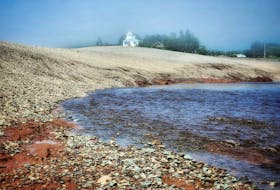KINGS COUNTY, N.S. - Just as the inscriptions etched in stone eventually wear with the aid of weather and time, the names immortalized by grave markers or memorial tributes fade from memory with each passing generation until the stories behind the stones are no longer familiar to visitors strolling through the rows upon rows of stones lining cemeteries.
Every stone has a story, some more well-known than others.

1. William Hall, VC - Nova Scotia’s first Victoria Cross recipient
1827 – 1904
Hantsport Baptist Church
A memorial cairn marking the final resting place of Nova Scotia’s first Victoria Cross recipient stands near the Hantsport Baptist Church. William Hall was not only the first Nova Scotian to receive the British Empire’s most prestigious award for bravery, he was also the first Victoria Cross recipient of African descent. A Maritime Museum of the Atlantic article entitled “William Hall, VC” states he was born in Horton and spent several years working in the shipyards of Hantsport before eventually enlisting in the British Royal Navy.
The inscription on Hall’s memorial in Hantsport traces his Victoria Cross distinction back to his service with HMS Shannon on Nov. 16, 1857.
“Hall was part of a crew under command of a lieutenant which placed a 24-pounder gun near the angle of the Shah Nujjiff at Lucknow. When all but the lieutenant and Hall were either killed or wounded, Hall, with utter disregard for life, kept loading and firing the gun until the wall had been breached and the relief of Lucknow had been assured,” the monument reads.
Hall returned to Avonport to farm and live with his sisters following his time in the service, and was originally buried without military honours in an unmarked grave after succumbing to paralysis in 1904. A local legion movement launched in 1937 eventually resulted in Hall being reburied at the Hantsport Baptist Church property, in a resting place recognizing the heroic efforts of the historic Victoria Cross recipient.
More on William Hall: Able-Seaman William Neilson Edward Hall

2. Margaret Florence Trueman – first woman to graduate from Dalhousie
1857 to 1935
Cornwallis Reformed Presbyterian Covenanter Church Cemetery in Grafton
A Dalhousie University library article devoted to Margaret Trueman (nee Newcombe) lists the Grafton native as the first female graduate of the Halifax-based post-secondary institution.
Then in her late 20s, Trueman obtained her first degree in April 1885. She held a provincial teaching license prior to enrolling in the Bachelor of Arts program, and won prizes in English literature, history, German and political economy while studying at Dalhousie.
She would go on to earn a Masters of Art History from Dalhousie in 1911, and later became the principal of the Halifax Ladies College. She retired at 61 and moved back to the Annapolis Valley, where she died of pneumonia in 1935.
Related:
One day only: Historic Grafton church to hold summer service Aug. 5

3. Alfred Carl Fuller – The Fuller Brush Man (iconic industrialist)
1885 to 1973
Pleasant Valley Cemetery
It’s not hard to find Alfred Carl Fuller’s monumental memorial at Pleasant Valley Cemetery.
And you can bet there’s a story behind the larger than life Fuller tribute located in the rural setting a stone’s throw from the Town of Berwick.
This iconic door-to-door salesman from the early to mid-1900s rose to relevance as a Welsford-born American entrepreneur who turned a line of brushes into a multi-million-dollar business venture. Aptly dubbed the Fuller Brush Man, the self-proclaimed “country bumpkin” lived out a real-life rags to riches tale as he evolved from one of 12 siblings growing up on a family farm in Nova Scotia, to the founder of the world-renowned Fuller Brush Company.
According to Encyclopedia.com, Fuller started out as a brush and mop salesperson in 1905. He had relocated to Boston to live with his sister and explore new opportunities at the age of 18, and gradually saved enough money to start his own business.
He developed a product line that would eventually grow to include more than 700 types of brushes to meet a housekeeper’s every need based on the knowledge he gained interacting with customers.
“The line of brushes sold by Alfred Fuller (1885-1973) took him from rags to riches. He felt that products should be made to work correctly and to last a long time,” the website states. “This idea was new at the beginning of the 20th century, when cleaning tools were poorly constructed and needed to be replaced often.”
Fuller’s success would eventually catch the attention of filmmakers in Hollywood, inspiring a Fuller Brushman movie and “The Fuller Brush Woman” film starring Lucille Ball.
Encylopedia.com reports the Connecticut-based business, formally named Fuller Brush Company in 1910, reached $15 million in sales and had thousands of door-to-door salesmen working as independent contractors on the streets by 1923.

4. Arthur Wentworth Hamilton Eaton – ‘definitive historian’
1849 to 1937
Oakgrove Cemetery in Kentville
Prolific Harvard-educated scholar and writer Arthur Wentworth Hamilton Eaton was the son of a Planter who was involved in the construction of the Wellington Dyke. Eaton, also a clergyman, had a keen interest in history, and many of the works he penned, including A History of Kings County (1910), are available through Acadia University’s library.
“Though in the ‘Boston states’ Eaton understandably kept quiet about his maternal great-grandfather Henry Hamilton, who had been a Tory refugee, his own career, mostly spent in New England, gave him the intellectual distance and historical perspective necessary to write impartially and with profound insight about the origin and development of English Nova Scotia as the “new” New England,” states a Dictionary of Canadian Biography article penned about Eaton.
“Eaton’s historical, though not his literary, work has stood the test of time, scarcely equalled much less exceeded … Eaton would come to be regarded as the definitive historian of the loyalist period in his native province.”

5. Mona Louise Parsons – 1940s war hero to allied airmen
Willowbank Cemetery, Wolfville
1901-1976
The tombstone doesn’t begin to tell the tale.
A life-sized sculpture of this Middleton-born war hero stands in the Town of Wolfville, offering everlasting recognition of accounts of bravery that went untold for decades.
Mona Parsons died long before the sculpture was erected in her honour in May 2017. A statement prepared by the group behind The Mona Parsons Project says she passed away without receiving recognition for her heroic efforts during the Second World War.
“Married to a well-to-do Dutch man, Parsons was sentenced to death in 1941 for hiding Allied airmen in their house near Amsterdam. She spent the rest of the war in forced labour camps in Nazi Germany, and then escaped by walking to the border of the Netherlands,” a Mona Parsons Project statement reads.
“Parsons was the only Canadian female civilian to be imprisoned by the Nazis and her bravery was unrecognized in Canada until a play (1997) and a book about her exploits (2000) written by Andrea Hill-Lehr.”
Parsons, who worked as a nurse during The Great Depression, met her first husband after moving to New York City in 1929 as an aspiring actress.
“Parsons never wore a military uniform, but she was willing to lay her life on the line for freedom. From a Nova Scotian childhood, a Depression-era nurse, an underground worker in the resistance, a prisoner of the Nazis, and an emaciated fugitive who walked across Germany in the last months of the Second World War, Mona Parsons was a true hero,” a Nova Scotia Heritage Day article about Parsons reads.
Parsons returned to Nova Scotia after the war and remarried. She died in Wolfville in 1976.
READ MORE ABOUT MONA:
Mona Parsons remembered during Heritage Day with events in Wolfville, Middleton
Forgotten Annapolis Valley war hero: from socialite to the Dutch Resistance

6. Sir Frederick William Borden – influential Canadian politician
1847-1917
Hillaton Cemetery
Born in Cornwallis, Nova Scotia Sir Frederick Borden went on to study at Harvard University. He eventually returned to his home province to practice medicine and settled in Canning. He was elected as a member of the House of Commons as a Liberal Party representative in 1874 and served as an influential minister of militia and defence under Prime Minister Sir Wilfred Laurier from 1896-1911, ultimately playing a key role in aiding in the creation of a strong foundation for the Canadian military before the First World War. There is a Canadian Forces base in Ontario and village in Saskatchewan named after Borden.
A review John MacFarlane wrote of Carman Miller’s book A Knight in Politics: A Biography of Sir Frederick Borden says, “a medical doctor in Canning, Nova Scotia, Borden became an important member of the community where his family had deep roots. Aided by inheritance and marriage, as well as the ability to use his opportunities well, he invested in ships, land, and other aspects of the regional economy.”
His cousin, Grand Pré native Sir Robert Laird Borden, served as Canada’s eighth prime minister from 1911 to 1920. He was tasked with leading the country during the First World War.
SEE ALSO: Proprietor honoured to have Upper Canard’s Borden House featured in photographic exhibit

7. Silas Tertius Rand– clergyman, missionary, ethnologist, linguist, translator
1810-1889
Riverbank Cemetery, Hantsport
A Canadian Bapist clergyman born in Cornwallis, Annapolis County, Rand is known for his work focusing on the Mi’kmaq people of Atlantic Canada. He is credited as the first to record the legend of Glooscap. He moved to Hantsport in 1853.
A Silas Tertius Rand biography penned by Dalhousie University history professor Judith Fingard states: “Rand devoted more and more time to his study of (Mi’kmaq) culture as the years passed, a study which won him recognition abroad and honorary degrees at home as he produced his scriptural translations in (Mi’kmaq) and Malecite, compiled his (Mi’kmaq) dictionary, and collected scores of legends including the time-honoured tales of Glooscap, the mythological hero of the (Mi’kmaq).”
Read more about Rand: The life, legends of Kluskap

8. Perez Coldwell – “…a man from Gaspereau”
1808-1852
Gaspereau Cemetery
A commemorative plaque was unveiled in the Gaspereau Cemetery on June 7, 2000 to tell the tragic tale of “the loss of the six precious souls and a man from Gaspereau.”
“Perez Coldwell, with professor Chipman and others from Acadia College, was drowned in the Minas Basin, 7 June 1852. The geological group was returning from a rock study at Cape Blomidon when weather conditions sank the sailboat. Only the other crew member, George Benjamin, survived,” the monument reads.
Coldwell, who had a twin sister, was never seen again but it was far from a case of out of sight, out of mind. Locals long recounted the tale of “a man from Gaspereau.”

9. Mary Peake – first Canadian servicewoman to die in the Second World War
Died March 24, 1942
St. John’s Anglican Church burial ground, Port Williams
A monument at the St. John’s Anglican Church property in Port Williams pays tribute to the life of Mary Clerk Peake, who was baptized at the local church in 1899 and raised on her family’s farm on Church Street. The monument explains that Peake eventually left the area for university studies and to work abroad in the medical field.
“Mary joined the Canadian Women’s Army Corps in 1940 and gave her life overseas driving an ambulance for the British Red Cross during an air raid. She was killed on active duty 24 March 1942 and lies buried in England, the first Canadian servicewoman to die in World War II,” her monument reads.

10. George Price – last Canadian serviceman to die in the First World War
Died Nov. 11, 1918
St. John’s Anglican Church burial ground, Port Williams
George Lawrence Price was baptized at the Saint John’s Church in Port Williams in 1893. A monument erected at the church property in his honour in 2010 says Price was raised on his family’s farm on Church Street and eventually left Port Williams to work in Saskatchewan.
Price joined the Canadian Infantry Brigade in 1917 and committed to serve his country overseas.
“George survived a mustard gas injury on the Western Front and was shot by an enemy sniper minutes before the Armistice ended hostilities,” Price’s memorial monument in Port Williams reads. “He was killed in action 11 November 1918 and lies buried in Belgium, the last Canadian serviceman to die in World War.”









